Wallpaper for a small hallway: which one to choose?

Wallpaper is a great solution for wall decoration. They can be purchased for any layout and interior style. Today we will talk about how to choose the right canvases for a small hallway.
Views
Currently, there are a great variety of materials for wall decoration for every taste and color. However, the most popular and common choices are plain old wallpapers. Fortunately, the modern consumer can choose from a wide range of them. Each type of wallpaper has its own advantages and disadvantages, which should be discussed in detail.

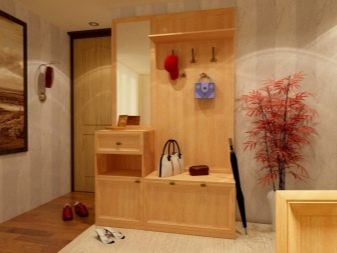
Paper
These wallpapers are the most affordable, which makes them very popular and widespread. In addition to the low cost, such canvases can boast of other positive qualities. These include their environmental friendliness, because paper wallpaper consists of pure cellulose.
It is worth noting that modern consumers are faced with the widest range of paper wallpapers of various colors. In stores you can find a lot of beautiful and varied canvases, which can also be decorated with spectacular prints or patterns.
Also, many owners opt for these options because of their breathability. Thanks to this characteristic, fungus or mold does not appear on paper wallpaper.

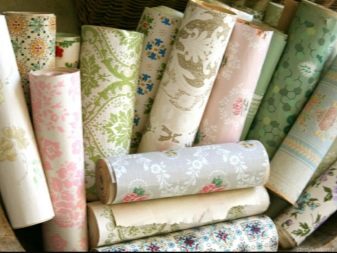
However, these affordable and popular finishing materials have their drawbacks. These include the following parameters:
- paper canvases are afraid of moisture and cannot be washed;
- they can be easily damaged and spoil the attractive appearance;
- over time, they lose their color saturation.
Because of such disadvantages, paper wallpaper is not recommended to be glued in a small hallway, since in such conditions they can quickly get dirty, and, as you know, it is impossible to wash them. In addition, there are often a large number of objects with sharp corners in such rooms, which can damage paper sheets that are unstable to mechanical damage.


Vinyl
Vinyl wallpapers are very popular and widespread today, as they have many positive characteristics. There are several types of such paintings:
- flat vinyl. This finishing material has a simple and smooth surface;
- thick vinyl. Such wallpapers are very dense and strong;
- foamed vinyl. Such options have a characteristic volumetric structure.

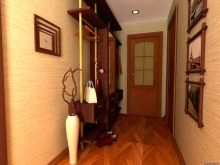
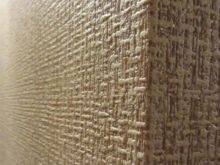
Many buyers today choose original vinyl canvases that imitate wood, stone, brick or plaster. The main advantages of such finishing options are their wear resistance, durability, heat resistance, low cost and resistance to dampness and moisture.
The disadvantages of vinyl sheets are that they are not breathable, which can lead to the formation of mildew and mold on their surface. It is also worth noting that these wallpapers are not environmentally friendly.
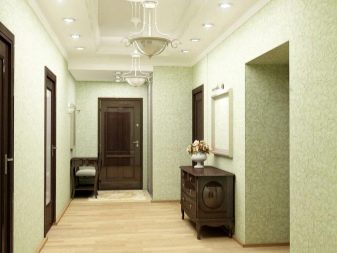
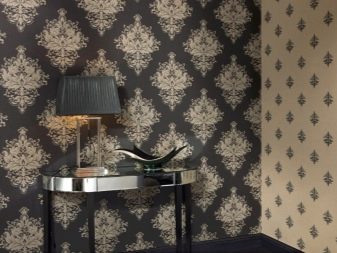
Vinyl wallpaper will fit well into the atmosphere of a compact hallway, since it can be washed and is not subject to mechanical damage.
Non-woven
Non-woven wallpaper is another type of finishing material that is popular with modern consumers.Such canvases can have a variety of intricate patterns, with the help of which the interior will become unusually attractive and unique. However, such canvases are not cheap.
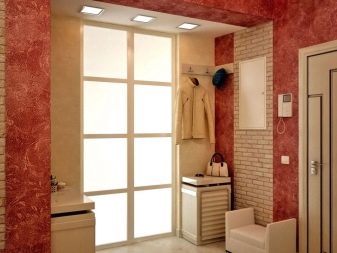
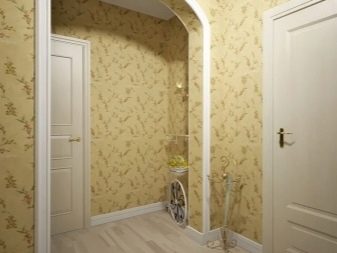
Non-woven wallpaper boasts a number of significant advantages, which include:
- wear resistance;
- environmentally friendly composition;
- resistance to temperature extremes;
- moisture resistance.
The disadvantage of such finishing materials can be attributed to their high cost, not the widest range and transparency.

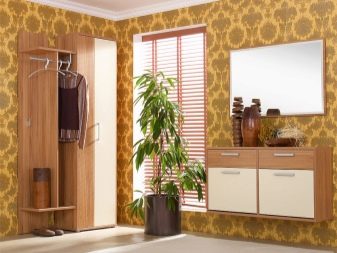
Non-woven wallpaper can be used to decorate a small hallway. Moreover, it is permissible to change their appearance at your discretion, since they are easily painted.
Textile
Textile wallpaper looks beautiful, expensive and original in the interior. Such finishing materials are environmentally friendly and have excellent thermal insulation properties. Their appearance is also unique, and not only due to the woven texture, but also the absence of seams.

However, such canvases should be treated more carefully. They are easily soiled and accumulate dust on their surface. In addition, to apply them to the wall, you need to have the appropriate skills. Many consumers call such wallpaper a disadvantage and too high a price. Woven fabrics are not recommended for finishing the hallway, as they quickly get dirty.
Liquid
These types of wallpaper have recently appeared on the market. They are similar in appearance to plaster and are available in powder form. Dilute with water before applying to the wall. The advantages of these finishing materials include:
- environmental friendliness;
- ease of use;
- seamless structure;
- preservation of bright color for many years;
- soundproofing;
- ease in correcting any damage and defects.
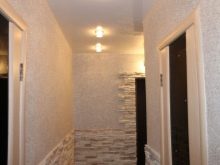
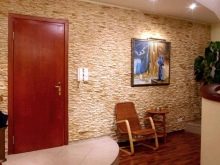
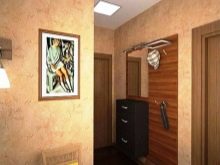
The disadvantage of liquid wallpaper is that it can be washed off with water. In addition, in stores you can rarely find a large assortment of colors for such materials.
How to glue correctly?
Different types of wallpaper are applied to walls in different ways. For example:
- Paper canvases must be glued with an overlap, and it does not matter at all how thick they are. In the hallway, this wallpaper should be glued from the front door, then move "in a circle" and finally return to it.
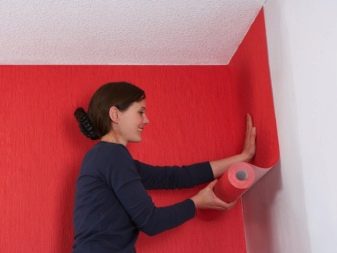
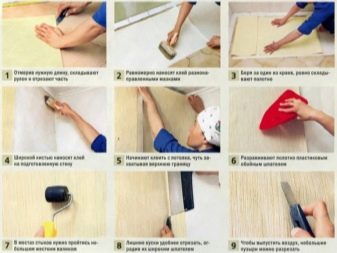
- Non-woven wallpaper needs to be glued end-to-end and you can start from anywhere in the hallway. Similarly applied to walls and vinyl materials.

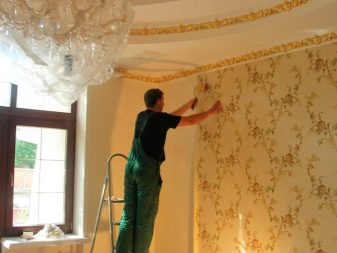
- Textile wallpaper is not recommended for use in the decoration of the hallway, however, if you firmly decided to turn to these particular canvases, then it is better to entrust their installation to specialists. This is due to the complexity of working with such a finishing material.

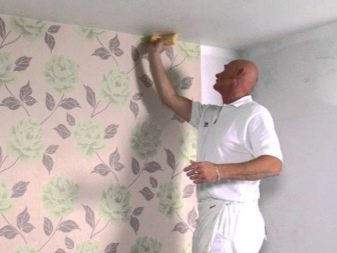
- Liquid wallpaper is applied to the walls according to the plaster principle. Experts also do not recommend finishing the surfaces in the hallway with a similar material, since it is better not to wash it with water, and in such a room the walls can quickly get dirty and require cleaning.
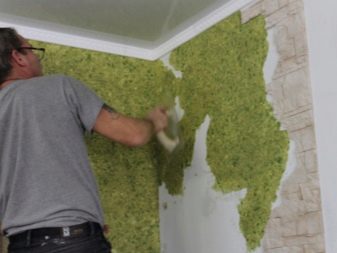
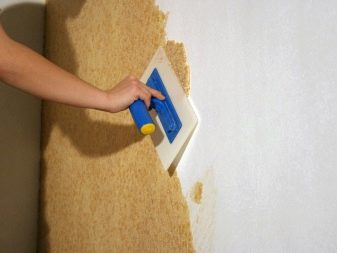
Shade options
Modern manufacturers produce wallpapers in a wide variety of colors. In a small hallway, many finishes will look good.
Bright and rich canvases are not so often used in the decoration of hallways, however, in a small room, such a color scheme will be appropriate. This is due to the fact that with the help of rich colors you can visually align the layout, especially if you stick such wallpaper on a far wall or on a surface that is opposite each other.
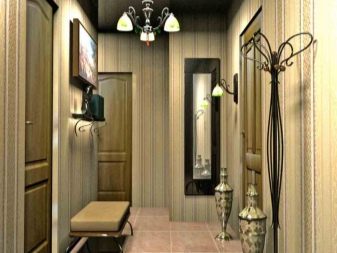
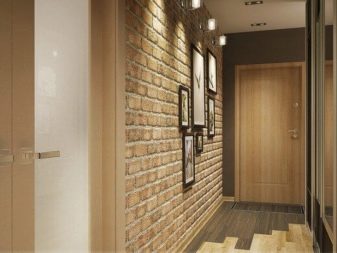
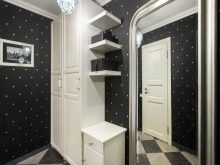
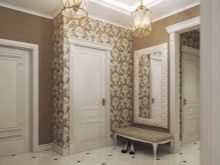
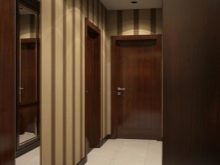
Most often, owners choose lighter shades of wallpaper for finishing compact corridors. The most popular and attractive canvases are white, beige, pale pink, cream, light caramel or sky blue. Such soft and discreet wallpaper can be used to decorate the entire perimeter of the hallway.
Many owners are afraid to decorate the hallways with wallpaper that has a dark tone, considering it too gloomy and depressing.Indeed, such a color scheme is hardly suitable for a small-sized corridor. Black, dark blue or dark gray wallpapers are best used in larger rooms.
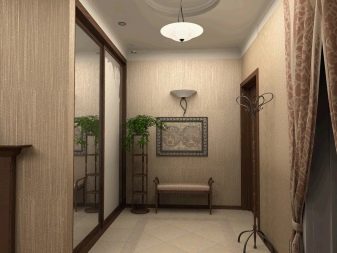
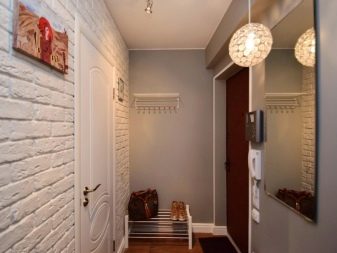
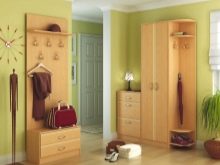
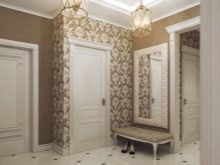
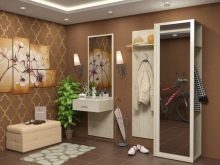
Drawing
Today in stores you can find many beautiful and original wallpapers, decorated with various patterns and interesting prints. Such canvases look very original and fresh, but for a small hallway, they should be chosen more carefully so as not to spoil the layout and make it even tighter. In the selection of such wallpapers, the following nuances must be taken into account:
- canvases with large drawings and patterns can visually reduce the space and make it overloaded;
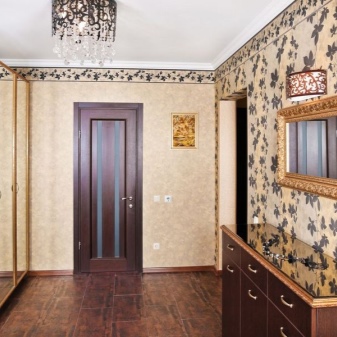
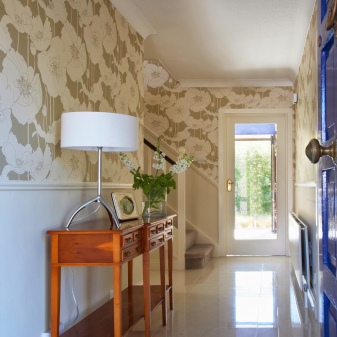
- horizontal patterns are a good solution for the visual expansion of the hallway. However, such finishing materials can visually make ceilings lower;
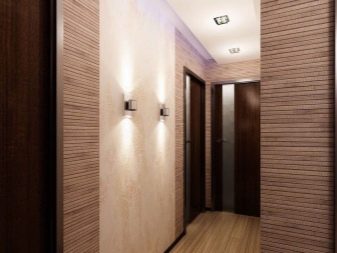
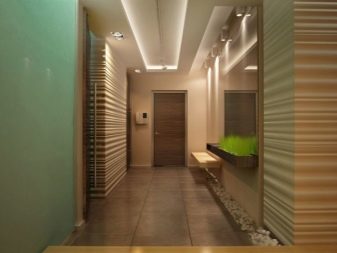
- vertical patterns and classic stripes raise the ceiling, but make the room narrower;
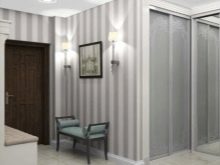
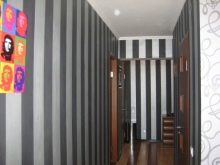
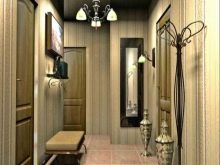
- it is not recommended to decorate the design of a small hallway with wallpaper with small prints that have many details. Such wallpapers will not only constrain an already small space, but also make it very uncomfortable;
- Today, wallpapers with abstraction patterns and prints are very popular. Such canvases can be used in a small hallway, but you should give preference to options for calm and neutral shades. Some varieties with a 3D effect can visually enlarge the room.
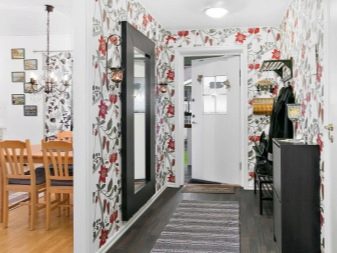
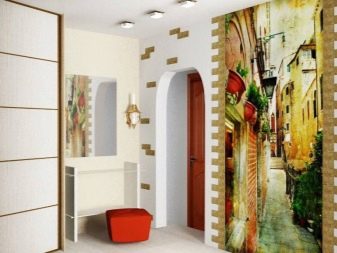
Which ones are right?
Small-sized hallways have ceased to be a sentence today and they can be designed in such a way that visually the space will seem more spacious, comfortable and, of course, stylish. For example, a miniature corridor in a "Khrushchev" can be transformed if you choose the right light or pastel color scheme or a lightweight wallpaper pattern.
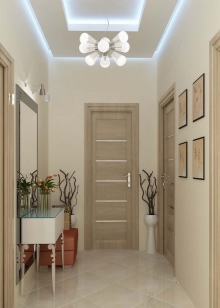
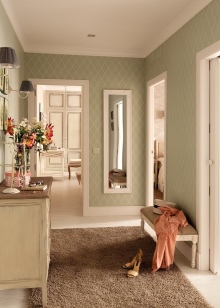
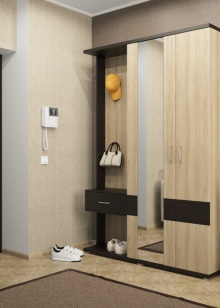
It is recommended to use canvases that visually enlarge the space. Light canvases with minimalistic patterns are ideal for this. You can also visually change the layout using striped wallpaper, but here it all depends on the specific case. For example, for very narrow rooms it is worth choosing a horizontal strip, and for hallways with low ceilings - a vertical one.
Combined wallpaper is also suitable for finishing a small hallway in an apartment. For example, it can be an original tandem of plain colors and canvases with patterns. Often the owners of "Khrushchevs" turn to this design.


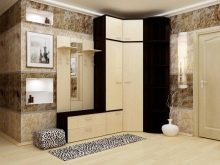
In the selection of wallpaper for the hallway, do not forget that such a room is prone to dirt, so you should not glue soiled and not wear-resistant canvases in it, since under these conditions they will quickly lose their beautiful appearance. Moreover, materials that cannot be washed will have to be re-glued altogether.
Beautiful interiors
In a narrow hallway, not only plain light wallpaper will look great, but also coatings that imitate a light stone. Especially interesting and organic, such canvases look opposite each other (on opposite walls). Against their background, brown doors and mirrors with a similar edging will stand out perfectly.
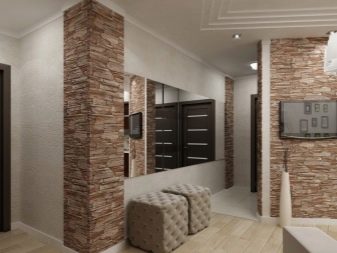
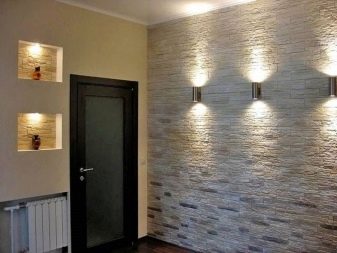
If you want to decorate a small hallway in the style loft, then you should turn to the snow-white wall decoration, adding one of them with white decorative brick. Place a light wooden bench and a large mirror with a wooden frame in such an environment. Such "refreshing" paints should be diluted with decorative pillows in natural shades and wrought-iron black hangers on the wall.
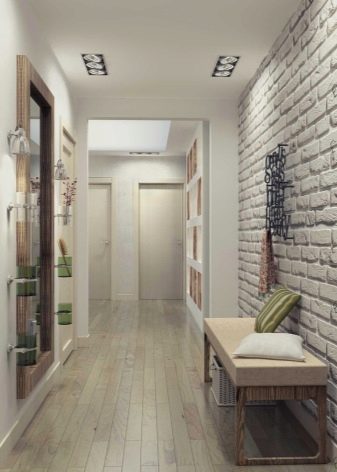
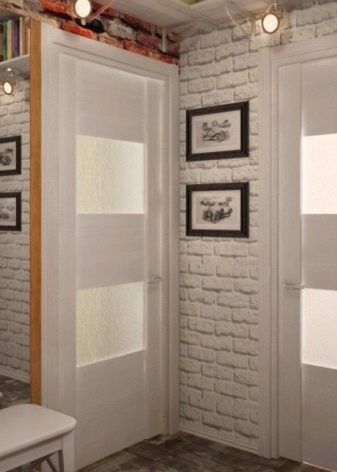
Lovers of simple but harmonious solutions will like the design of the hallway, in which the walls are decorated with wallpaper in a light gray shade, and the floor and ceiling are covered with beige materials. Against such a background, brown panel doors, a snow-white bench with a cream seat and the same light wall hanger will stand out effectively. To complete such a simple but organic ensemble, you can use a coffee-colored floor rug.
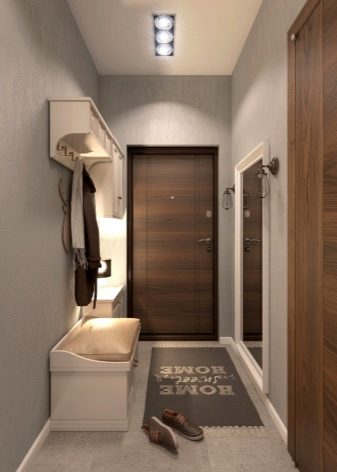
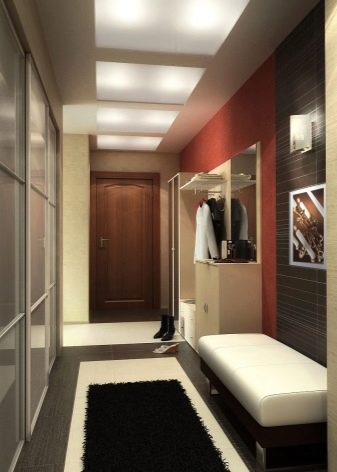
In addition to light wallpaper, large mirrors can be used in a small hallway, which will also have a beneficial effect on the visual expansion of the available space. It is advisable to select furniture, doors, hangers and mirror frames made in the same color or shade.
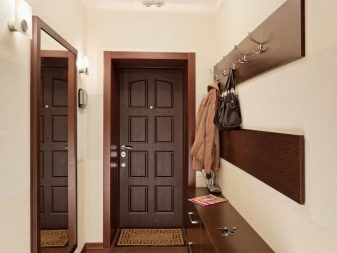
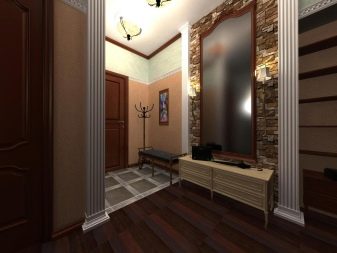
Bright wallpapers with prints of unobtrusive shades will look attractive in the corridor, but it is recommended to glue them a little further from the front door. For example, in a snow-white space with a beige floor decorated with chocolate patterns, organically golden wallpaper with unobtrusive prints, located at the end of the hallway, will look.
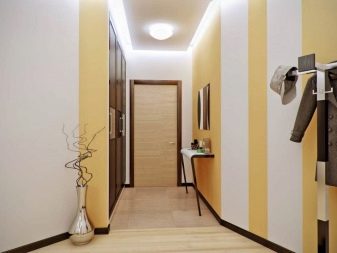
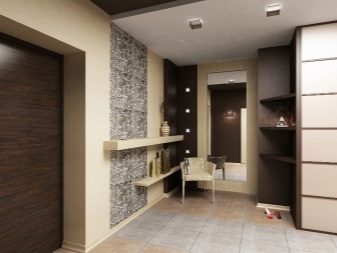
A contrasting combination of black and white colors will look boldly in the interior of a small hallway. You should be careful with such decisions. For example, in a very small room, white wallpaper can be glued to the walls, and the ceiling can be finished with the same light plaster. Contrasting black tiles with diamond-shaped patterns will dilute this finish. Round off the ensemble with a small wrought iron chandelier and a dark, antique-style wooden bench.
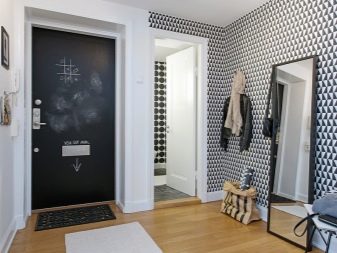

For information on how to choose wallpaper for a small hallway, see the next video.













The comment was sent successfully.